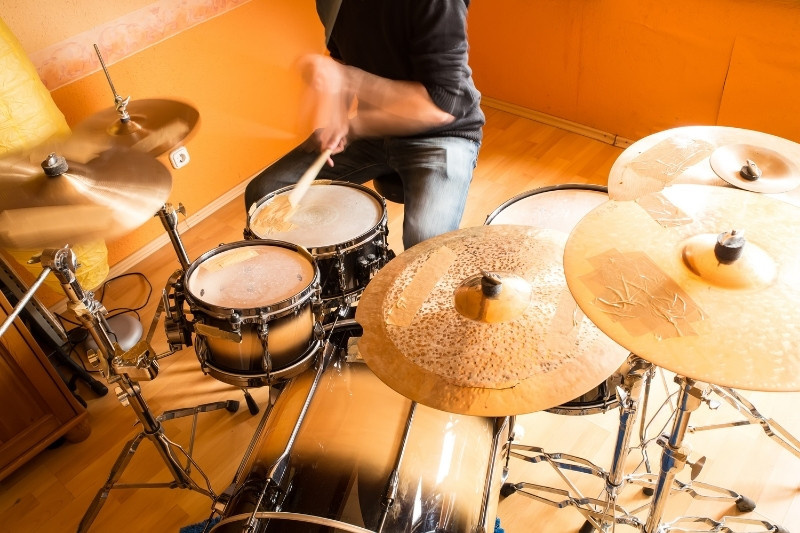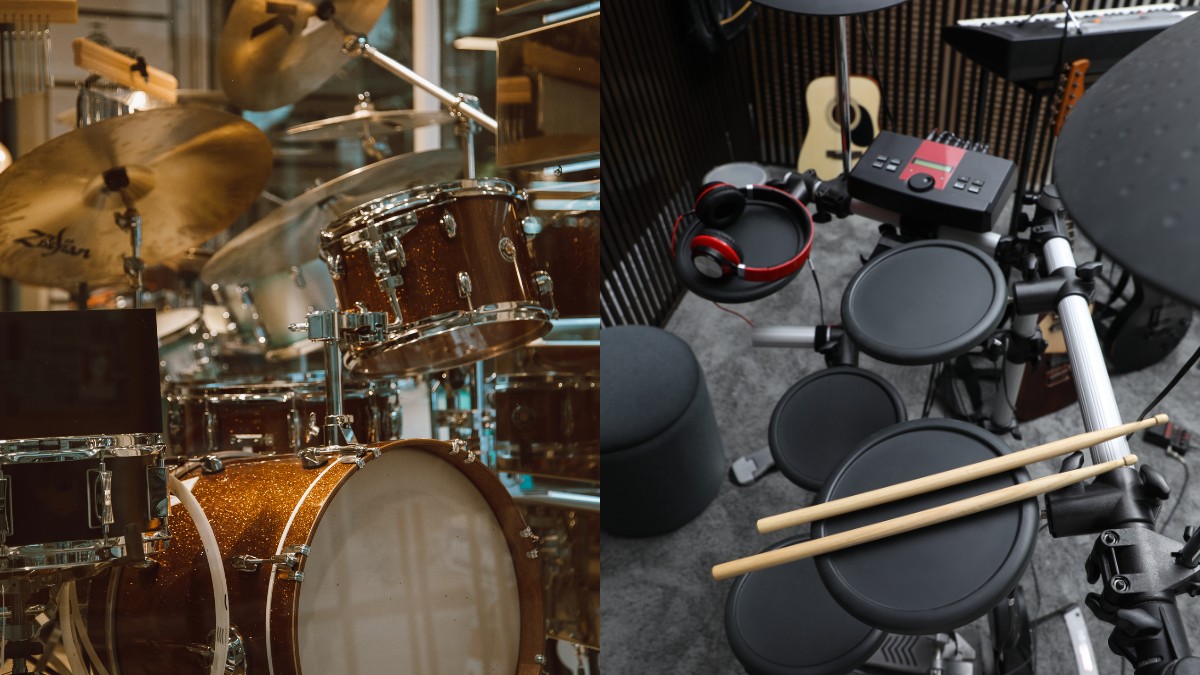Drumming ‘In The Pocket’ (How to Become a Pocket Drummer)

Drumming ‘in the pocket’ means three things: having great timing, a great groove, and serving the music. Playing in such a way allows you to create a ‘pocket’ that gives other musicians in your band space to play.
Striking a great balance between these sometimes subtle concepts is what separates a good drummer from a great drummer.
Every drummer should strive to become a ‘pocket drummer.’ When you are playing in the pocket, you are playing with the music, and it sometimes means playing in a sweet spot between timing and groove.
This may be a confusing concept at first because having great timing allows you not to veer off or have large increases or decreases in timing throughout a song.
However, playing with a groove humanizes the beat. It’s those minor subtleties in the placement of your strokes throughout the bar. It’s the minor changes in dynamics and ghost notes.
This can humanize a beat and make it sound much more musical.
Contents
Drumming ‘In The Pocket’ at a Glance
- Drumming ‘in the pocket’ combines the balance of timing, groove, and serving the music.
- Becoming a ‘pocket drummer’ requires great timing and groove harmony.
- Good timing maintains consistency, while groove humanizes the beat.
- Serving the music means playing thoughtfully, not for self-display.
- Deep pocket drummers excel without flashiness or high technical skill.
- To improve as a pocket drummer, serve the music, manage dynamics, and avoid overcomplicating beats.
- ‘Out of the pocket’ drumming is too metronomic, lacks groove, or neglects to serve the music.
- Real drummers add subtle variations for a more realistic and musical sound.
Serving the music is an overarching principle that you should strive for in drumming, which means that your drum beats and fills should be arranged and placed thoughtfully and tastefully in a way that will serve the song as a whole.
It’s not intended as a medium for you to show off. A ‘deep pocket drummer’ does not need to be flashy or have serious drumming chops.
A deep pocket drummer may be technically less adept while still putting on an outstanding drumming performance.
How do you become a better pocket drummer?
Start Serving The Music

This is a point that has been repeated so many times on this blog! As much as you need to strive to improve your drum chops, you need to be careful about how you use them when playing music.
Sometimes, all you need is a simple four-to-the-floor beat; sometimes, even the best jazz drummers in the world just need a staple ride cymbal groove with slight changes throughout the song.
What’s amazing is that sometimes, the best drummers in the world can make even the most basic of beats sound amazing! These play these basic beats ‘in the pocket.’
Watch Your Dynamics
Pocket drummers often play with deep dynamics. They know that even the slightest change in their strokes throughout a beat can change the sound.
For example, you are changing the sticking weight of your hi-hats throughout the bar, having slight accents on the off beats, and changing the placement of your strokes slightly off time even, if appropriate!
Don’t Overcomplicate Things (unless that happens to suit the music!)

Pocket drumming does not mean you always have to play ON the beat!
Sometimes, a song may sound great with polyrhythms and syncopation. This is perfectly fine to do, and it can very well be possible to play these very nicely in the pocket as long as the songs work well with this type of beat.
Playing the kind of beats does not mean that a drummer is playing out of pocket, as long as they’re playing tastefully to the song.
Drumming ‘out of the pocket’
Drumming out of pocket is, of course, the complete opposite of drumming in the pocket. It is ANY combination of where the drummer is being too metronomic, is not playing with enough groove, or where they are not serving the music.
Playing very metronomically can mean that the drummer is playing very tightly. There may be playing exactly in time, but with very few dynamics or interesting subtle changes to the beat.
The same applies to playing without groove; playing out of pocket can also mean that the drummer is not humanizing the sticking of their drum beats.
Drum machines often use quantization, i.e., where a drum beat is aligned exactly to a grid. This can make it sound very metronomic, and not humanized. Real drummers use slight variations in their playing, and it makes it sound a lot more realistic and more musical.
Here are some examples of playing against the music (of course, these are just examples, and they certainly don’t apply to all styles):
- Adding fills in the wrong places
- Hitting the crash cymbals far too often
- Overcomplicating beats and fills
- Too much showing off!
Famous Pocket Drummers
Hal Blaine
Hal Blaine, an influential session drummer, is often credited with inventing modern pop drumming. As a member of The Wrecking Crew, he laid the foundation for numerous iconic songs in the 1960s and 1970s, contributing to various music styles. His ability to create the perfect drum part, regardless of genre or complexity, is exemplified in tracks like The Carpenters’ “Close To You,” featuring his deep tom fills.
Chad Smith
Chad Smith, the Red Hot Chili Peppers drummer, adopts a decidedly assertive style when it comes to pocket drumming. His ability to forge a profound pocket groove, characterized by its energy rather than smoothness, sets him apart as an accomplished pocket drummer. Smith is a compelling illustration of how pocket drumming can be seamlessly applied across various musical genres.
Kenny Aronoff
Kenny Aronoff is renowned for his powerful and precise drumming style, often stepping in to replace less capable drummers on major-label tracks. He gained recognition while playing with John Cougar Mellencamp and has since become a sought-after studio drummer known for his skillful beat placement. His extensive discography showcases his versatile talent, featuring artists like Rob Thomas, John Fogerty, Stryper, and Les Paul & Friends.
Ringo Starr
Ringo Starr, known for prioritizing musical taste over technical prowess, played a pivotal role during The Beatles’ six albums by crafting grooves that perfectly complemented their diverse musical styles. He set a template for session drummers to follow, evolving his style to suit the band’s changing sound. He continued his influential career as a session drummer and a celebrated musician, leading Ringo Starr & His All Starr Band.
Nate Smith
Nate Smith is a renowned drummer celebrated for his exceptional groove. With a modern jazz sensibility, he excels at playing in the pocket. His album “Pocket Change” is a testament to his skill in maintaining engaging rhythms that captivate listeners.
Summary
Being a pocket drummer is not about always playing the bare minimum. It’s about knowing when to play less and also knowing when to use more subtlety in your drumming to get the best groove factor for a song.
Being sensitive enough to know what is appropriate for the musical style you are playing in and having an understanding that there are times when simplicity and subtlety are the best way to go!
Practice is everything when it comes to improving your pocket drumming. The more you play with different musicians, the more you will know what is appropriate to do during songs.
Playing songs at home will help your timing improve. The more music you listen to, the better an idea of when something sounds good together in a song you will have!







